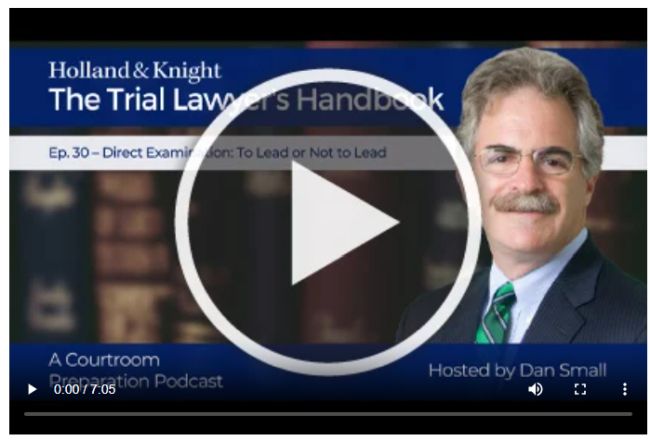- in United States
- with readers working within the Oil & Gas industries
- within Compliance topic(s)
In this episode of "The Trial Lawyer's Handbook" podcast series, litigation attorney Dan Small explores how to avoid asking leading questions during direct examination. The Federal Rules of Evidence state that lawyers should not use these types of questions when examining a witness, except when necessary to develop the witness' testimony. Mr. Small recommends using concise and straightforward "W" questions — who, what, when, where, why and how — to allow witnesses to freely share their story without shifting the jury's focus to the attorney. He also notes that asking leading questions can leave a negative impression on judges, which can be fatal to a lawyer's case. He emphasizes that by refraining from asking leading questions, the overall case can be strengthened.
Listen and subscribe on Amazon.
Listen and subscribe on Apple Podcasts.
Listen and subscribe on SoundCloud.
Listen and subscribe on Spotify.
Watch and subscribe on YouTube.
Mr. Small is also the author of the new American Bar Association (ABA) book Lessons Learned from a Life on Trial: Landmark Cases from a Veteran Litigator and what They Can Teach Trial Lawyers.
Podcast Transcript
Too many lawyers view the rule against leading questions on direct examination as a technical, legalistic annoyance. But just the opposite is really true. The rule against leading on direct, far from being an obstacle, is actually one of those rare rules that makes sense, and it will improve your case if you follow it. Amazing.
The whole idea is to let the witness tell their story. Leading gets in the way. Federal Rule of Evidence 611(c) provides that leading questions "should not be used on direct examination of a witness, except as may be necessary to develop the witnesses testimony." Too many lawyers consider it a rule to violate as often as you can get away with. But don't fall into that trap. Learn how to do it right and maintain the discipline necessary to keep doing it that way. Your case will be better for it, and you'll be a better lawyer for it.
For those of you who need a refresher, a leading question is one that suggests the answer. "Isn't it true that it's raining?" is a leading question. "What was the weather like?" is a non-leading or open question. Sometimes leading questions on direct are proper, such as when dealing with an adverse witness or laying an evidentiary foundation. But normally they're not. The easiest way to avoid leading is to begin your questions with the letter "W."
Years ago, I found in the writing of Rudyard Kipling in his "Just So Stories" a wonderful poem that really gives the guide to direct examination. Kipling wrote, "I keep six honest serving men. They taught me all I knew. Their names are what and why and when and how and where and who." Marvelous. Nearly all your questions on direct should be short and simple "W" questions combined if needed with extenders like "else" or "next." Use them unless there is a compelling reason to do otherwise. Who was at the meeting? Who else was at the meeting? When did it happen? What happened next? Where was it held? Why did you attend? Those kinds of questions aren't less complicated or sophisticated or lawyerly. They're superior in every way. They are what the jury wants to know.
Even if you can get away with it, there are lots of reasons not to lead on direct. One is that it changes the nature of the presentation — and generally not for the better. As I said, the witness, not you, is supposed to be telling the story. Leading questions focus the attention on the lawyer and away from the witness. When a witness responds with simply "yes" or "no," the narrative that lends a testimony its force begins to recede or even disappear entirely.
Leading questions on direct also tend to rush the presentation. Leading questions are like shorthand. You know the story. The witness knows the story. Pretty soon, you and the witness are off to the races, going through the story much too fast. The jury is lost. At a minimum, the testimony is likely to feel clipped or rushed. Excessive leading is also lazy and undisciplined. It's easy to acquire bad habits and hard to get rid of them. Stay in the habit of asking proper questions.
Finally, it violates the rules. Most judges dislike it, and some hate it. If you lead, the judge has to work harder. Worse, the judge may have the impression that you are either a) the kind of lawyer who doesn't know how to ask a proper question, or b) the kind of lawyer who cuts corners. Neither one is an impression you want to have with the judge.
While you may have good habits and avoid leading, your opponent may not. If your opponent starts leading, don't just sit there. If you need a shorthand way to remember when to object, listen for tag phrases or words that begin with the letters "D" or "C." Tag phrases are what lawyers put at the beginning or end of leading questions, such as "Isn't that true?" or "Wouldn't you agree?" or "Isn't that correct?" If the question has a tag phrase, it's leading. Object. "D" or "C" words are not as easy to spot, but usually signal a leading question. If a question begins with a word such as did, do, can or could, there is a pretty strong likelihood that what follows suggests the answer. If you are opposing counsel and you hear one of those "D" or "C" words, perk up, wake up. The question may not be leading, or it may not really matter, but be ready to object.
Leading on direct is unfortunately all too common. Some lawyers seem to think that the object of the game is to get away with as much leading as you can. You may get away with it, but it won't make your case any stronger and it won't endear you to the judge. Don't be lazy. Do it right. Ask the questions the way Rudyard Kipling would ask them.
The content of this article is intended to provide a general guide to the subject matter. Specialist advice should be sought about your specific circumstances.


